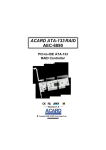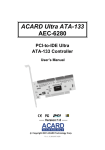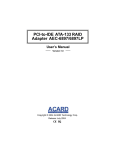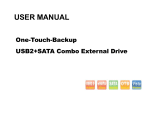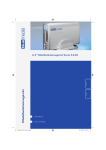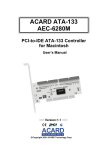Download Acard PCI-to-IDE ATA-133 User`s manual
Transcript
PCI-to-IDE ATA-133 RAID Controller AEC-6885 User’s Manual Version:1.0 Copyright © 2002 ACARD Technology Corp. Release: December 2002 Copyright and Trademarks The information of the product in this manual is subject to change without prior notice and does not represent a commitment on the part of the vendor, who assumes no liability or responsibility for any errors that may appear in this manual. ACARD and SCSIDE are the trademarks of ACARD Technology Corp. Microsoft and the Windows Logo are the registered trademarks, and Windows is the trademark of Microsoft Corporation. All brands and trademarks are the properties of their respective owners. This manual contains materials protected under International Copyright Laws. All rights reserved. No part of this manual may be reproduced in any form or by any means, electronic or mechanical, including photocopying, without the written permission of the manufacturer and the author. All inquires should be addressed to ACARD Technology Corp. Table of Contents Chapter 1 Introduction ....................................... 5 1.1 1.2 1.3 1.4 Overview ................................................................ Features ................................................................. Specifications ........................................................ Package.................................................................. 5 5 5 6 Chapter 2 Hardware Installation........................ 7 2.1 2.2 2.3 2.4 Quick Installation .................................................. The Board Layout.................................................. Connection of Cable and Power Cord ................ Compatibility ......................................................... 7 7 8 9 Chapter 3 BIOS Setup ...................................... 10 3.1 Description of Functions..................................... 11 3.1.1 3.1.2 3.1.3 3.1.4 3.1.5 3.1.6 Set RAID Modes ............................................................. 11 Build Mirror Disk ........................................................... 12 Quick Erase Disk ........................................................... 12 RAID Mode Help ............................................................ 12 Card Information ........................................................... 12 Set Boot Disk ................................................................. 12 3.2 Setting of RAID Mode ......................................... 12 3.2.1 3.2.2 3.2.3 3.2.4 Stripe Mode .................................................................... 13 Mirror Mode .................................................................... 14 Stripe + Mirror Mode ..................................................... 15 JBOD Mode .................................................................... 15 Chapter 4 System & Driver Installation .......... 16 4.1 In Win 2000/XP..................................................... 16 4.1.1 Install the Driver ............................................................ 16 4.1.2 Boot from AEC-6885 ..................................................... 21 4.2 In Win NT .............................................................. 21 4.2.1 Install the Driver ............................................................ 21 4.2.2 Boot from AEC-6885 ..................................................... 22 4.3 In Win 9X/ME........................................................ 22 4.3.1 Install the Driver ............................................................ 22 4.3.2 Boot from AEC-6885 ..................................................... 22 4.4 In Linux ................................................................ 22 Chapter 5 The AEC-6885 Utility ....................... 24 5.1 Install the Utility .................................................. 24 5.2 Operate the Utility ............................................... 24 5.2.1 5.2.2 5.2.3 5.2.4 5.2.5 5.2.6 5.2.7 File .................................................................................. 25 Action ............................................................................. 25 Option ............................................................................. 25 About .............................................................................. 25 System Info .................................................................... 26 Event Log ....................................................................... 26 Array Management ........................................................ 26 Chapter 6 Troubleshooting .............................. 27 Appendix A About RAID................................... 28 A-1 A-2 A-3 A-4 RAID 0 (Striping) ................................................ RAID 1 (Mirroring) .............................................. RAID 0+1 (Striping/Mirroring) ........................... JBOD (Just a Bunch of Disks) .......................... 28 29 29 30 Appendix B Make An Installation Disk ........... 31 Appendix C ASPITool32 Manager ................... 34 AEC-6885 User’s Manual Chapter 1 Introduction 1.1 Overview ACARD AEC-6885 is a PCI 64-bit, 4-channel, high-performance PCI PnP ATA 133 RAID card. It supports RAID 0, 1, 0+1, JBOD as well as Hot Swap, and is fit for servers and high-class workstations. 1.2 Features n n n n n A standalone PCI-to-IDE controller Data transfer rate up to 533/266MB/s Supports up to 8 IDE hard drives Supports Hot Swap (with an optional mobile rack) Hardware RAID 0, 1, 0+1, and JBOD NOTICE: When applying Hot Swap, you can only connect a hard drive to each channel, and set as the same mode (Master). Please refer to 3.2. 1.3 Specifications n Power requirement --- n Environment --- n n Humidity --Dimensions --- n Connectors --- Voltage: 3.3V +/– 2% 5V +/– 2% Current: 0.5A Max. Operating temperature: 0oC to 70oC Storage temperature: –20oC to 85oC 15% to 90% Width: 17.46cm Height: 8.26cm Four 40-pin IDE internal connectors 5 AEC-6885 User’s Manual 1.4 Package When you open the package, please examine the following items. n AEC-6885 × 1 n Internal ATA 133 Cable × 4 n Y-Splitter Power Cord × 2 n User’s Manual n ACARD Support CD × 1 6 AEC-6885 User’s Manual Chapter 2 Hardware Installation 2.1 Quick Installation Please follow the 7 steps to install AEC-6885 at once. (1). Be sure that the system power has been off. (2). Open the housing of PC. (3). Insert AEC-6885 into an available PCI slot firmly. (4). Screw AEC-6885 onto the housing. (5). Connect AEC-6885 to the hard drives with an ATA 133 cable. (6). Connect a 4-pin power cord to the hard drives. (7). Screw the housing and power on the system. 2.2 The Board Layout The layout of AEC-6885 board is shown as follows. IDE 3 IDE 1 IDE 4 IDE 2 LED 7 AEC-6885 User’s Manual 2.3 Connection of Cable and Power Cord Basically speaking, it is easy for any user to connect the ATA 133 cable and the 4pin power cord, because they are foolproof. The methods are given below. (1). Find out a color line of the ATA 133 cable indicating pin 1 of the connector. (2). Find out pin 1 of the IDE connector on the IDE hard drive. (see HDD’s manual) (3). Connect the ATA 133 cable to the IDE hard drive by pin 1 to pin 1. (4). Connect the 4-pin power cord to the IDE hard drive. Power Cable Slave Master Slave IDE hard drive Master NOTICE: The ATA 133 cable has three connectors. The blue connector is connected to AEC-6885, the middle one to HDD set as Slave and the remaining one to HDD set as Master. 8 AEC-6885 User’s Manual 2.4 Compatibility AEC-6885 is particularly designed for DMA hard drive, and has been fully tested with the hard drives available in laboratory. AEC-6885 supports various ATA 66/ 100/133 hard drives as listed below. C C C C C C Quantum Seagate IBM Maxtor Fujitsu Western Digital For the newest compatibility, please visit http://www.acard.com 9 AEC-6885 User’s Manual Chapter 3 BIOS Setup After installing AEC-6885 and booting the system, you will see the following figure appear immediately behind the figure of motherboard. The figure indicates your BIOS version, hard drive information, RAID status, etc. Figure 3-1 NOTICE: If a hard drive has been set as boot disk, there will be a * appearing before its model number. Please press Ctrl + <F1> or <F10> simultaneously to enter BIOS Setup Utility. Figure 3-2 10 AEC-6885 User’s Manual 3.1 Description of Functions On BIOS screen use <á>,<â> to change items, press <Enter> to select and confirm, and press <Esc> to cancel or exit (return to previous screen). Meanwhile at the bottom of the screen, you can see the model numbers of hard drives connected to the channels, the capacity, the RAID status and class. For example, U5 represents an Ultra 5 ATA100 hard drive. 3.1.1 Set RAID Modes There are 8 arrays built in AEC-6885. You can build or change your RAID mode on any array. Move cursor to “Set RAID Modes”, then press <Enter>, and Array 0 to Array 7 will appear. There are four RAID and one normal (none RAID) modes for selection once you press <Enter>. Set according to the prompt window. Please refer to 3.2 for the explanation of each RAID mode. Yet, you are suggested to use the Windows-based RAID Utility designed for AEC-6885. Its GUI is easy for operation. Please refer to Chapter 5. Figure 3-3 NOTICE: You can set a new array from Array 0 to 7. The number is simply for the system identification. After rebooting, the system will assign the newly set array a smaller number. It begins with Array 0. 11 AEC-6885 User’s Manual 3.1.2 Build Mirror Disk When changing a mirrored hard drive, you can rebuild the hard drive’s data by “Build Mirror Disk” according to the prompt upon booting. Please see 3.2.2. NOTICE: The rebuilding time depends on the size of RAID. You can press Ctrl + S to stop rebuilding. 3.1.3 Quick Erase Disk This function allows you to quickly erase the data on a selected hard drive. Beware that the data and the partitions will be completely erased. 3.1.4 RAID Mode Help This function chiefly tells you that RAID 0+1 must be composed of 4 Master or 4 Slave hard drives. In other words, the hard drives must be set alike. 3.1.5 Card Information This function indicates the I/O address, ROM address and IRQ number currently used by AEC-6885. 3.1.6 Set Boot Disk This function lets you select a hard drive or a pair of hard drives containing OS to boot. But you need to enter BIOS of the motherboard, then boot “Other Boot Device”. If a hard drive has been set as boot disk, there will be a * appearing before its model number as Figure 3-1 shows. 3.2 Setting of RAID Mode AEC-6885 supports RAID 0, 1, 0+1 and JBOD modes. The hardware setting related to each RAID mode is briefly described below. Yet, you are suggested to use the AEC-6885 RAID Utility to set RAID. Please refer to Chapter 5 and Appendix A. 12 AEC-6885 User’s Manual Select any array in “Set RAID Modes”, then press <Enter> to select a RAID mode. After selection, the screen will prompt “Please select disks to create array”, and the cursor will move to the display area of hard drive at the bottom of the screen. Use <á>,<â> to select hard drives. Green highlighted items can be selected but purple ones cannot. After selecting the hard drive, press <Esc> to return to the dialog box of “Set RAID Modes” and continue. Figure 3-4 NOTICE: AEC-6885 supports Hot Swap. In Mirroring (RAID 1 and 0+1), when one of the hard drives is damaged, you can directly replace it with a new one without powering off. The data of another hard drive in the array will be completely copied into the new one. When applying Hot Swap (together with ACARD’s HDD cabinet), you can only connect a hard drive to each channel, and set as the same mode (Master). 3.2.1 Stripe Mode This mode needs a pair of hard drives at least. After selection, you have to to determine the hard drives’ stripe block size. That depends on the size of files the array intends to access in order to use the hard drives fully. For example, you can select a larger stripe size for the array of random access, and a smaller one for that of sequential access. If there isn’t any special use, you are suggested to set as 64K. 13 AEC-6885 User’s Manual Figure 3-5 3.2.2 Mirror Mode This mode needs a pair of hard drives for each array. If the two hard drives you have chosen contain the same data, or different data that you don’t want to keep, you can select “Create Only”. But if not, please choose one of them as the source hard drive (label is disk0 or disk1), and copy the data from the source one to another. Figure 3-6 When one of the hard drives in mirror array is damaged, if you don’t have an HDD cabinet for Hot Swap, you have to power off, then change the hard drive. Upon booting anew, the screen will prompt you to use “Build Mirror Disk” in BIOS to rebuild. Please notice that if you connect the newly removed hard drive back to AEC6885, in the channel display area at the bottom of BIOS screen, the hard drive will be added to a new array (its number is different from the original mirror array). After choosing “Build Mirror Disk”, you will find the prompt: problem mirror array as shown below. If you want to update the hard drive’s contents in the array, click 1 to change to Non RAID, then combine it with another correct hard drive to Mirror Array according to the instructions on the screen. If you want to reserve the hard drive’s contents, click 2 to cancel the RAID setting so as to add the array you want to reserve. 14 AEC-6885 User’s Manual Figure 3-7 3.2.3 Stripe + Mirror Mode This mode needs four hard drives. You can connect four hard drives to four channels that are all set as Master or Slave. Besides, you have to select stripe block size, too. 3.2.4 JBOD Mode This mode means to add all selected hard drives and make them become a big one. 15 AEC-6885 User’s Manual Chapter 4 System & Driver Installation Driver installation varies somewhat in different operating systems. You can install the driver of AEC-6885 in an existing OS, or install a new OS to the hard drives connected to AEC-6885. The second method can be said to boot from AEC-6885. 4.1 In Win 2000/XP Here we only take Windows XP as an example to explain. 4.1.1 Install the Driver Please follow the steps given below to install the driver of AEC-6885. (1). After installing AEC-6885, boot the computer and enter Windows XP. (2). The system will detect a new device and require a directory to access. Select “Install from a list or specific location (Advanced)”. Then click “Next”. Figure 4-1 16 AEC-6885 User’s Manual (3). Follow the wizard. Windows XP will require the driver’s location. Select “Include this location in the search”. (4). Select “Browse” to find the driver’s directory of AEC6885.inf such as A:\WinXP. Figure 4-2 (5). After the wizard finds the driver, click “Next” to install it. Figure 4-3 17 AEC-6885 User’s Manual (6). Click “Continue Anyway” to continue the installation. Figure 4-4 (7). Follow the directions. The system will complete the setup automatically. Figure 4-5 18 AEC-6885 User’s Manual (8). After setup, please boot the system again, and click “My Computer”. Figure 4-6 (9). Find “View system information”, and double click it. Figure 4-7 19 AEC-6885 User’s Manual (10). In “System Properties” click “Hardware” and then “Device Manager”. Figure 4-8 (11). Under “SCSI and RAID Controllers” double click “ACARD AEC-6885 PCI Ultra ATA 133 RAID Controller” to see if the card has been installed successfully. Figure 4-9 20 AEC-6885 User’s Manual NOTICE: During driver installation, if you encounter the problem of Windows logo, please click “Continue Anyway”. Windows logo is a mechanism designed to prevent OS from working abnormally because of installing unidentified software. Yet, the driver of AEC-6885 is proven not to affect the entire work of OS. 4.1.2 Boot from AEC-6885 Please follow the steps given below to install a new OS to the hard drives connected to AEC-6885. Thus you can boot from AEC-6885. (1). Find the support CD containing the driver of AEC-6885 from the package. Copy the driver into a formatted floppy disk, and label it. Please refer to Appendix B. (2). If you want to boot from the RAID subsystem, please enter the BIOS of AEC6885 to build a RAID into which you intend to install an OS. (3). Place the original CD of Win 2000 or XP into CD-ROM, and boot from hence. (4). On seeing the first blue screen, you need to press <F6> to install the OS to the hard drives connected to SCSI or RAID card. After the installation program loads needed files, please press <S> and put the driver disk into floppy drive. (5). The installation program will load the driver of AEC-6885. And you can select the hard drives or array into which you intend to install the OS. Then follow the wizard to complete. (6). During installation, if you encounter the problem of Windows logo, please click “Continue Anyway”. 4.2 In Win NT 4.2.1 Install the Driver Please follow the steps given below to install the driver of AEC-6885. (1). After installing AEC-6885, boot the original system again. (2). Click “Control Panel”, “SCSI Adapters”, and “Drivers”. Then click “Add”. Put the driver disk or CD of AEC-6885 and specify the driver’s location. 21 AEC-6885 User’s Manual (3) Follow the wizard to complete. After execution, boot the system again. 4.2.2 Boot from AEC-6885 Please refer to 4.1.2. 4.3 In Win 9X/ME 4.3.1 Install the Driver (1). The procedures are similar to those in 4.1.1. Follow the wizard to complete. (2). After installation, boot the system again. Then click “My Computer”, “Control Panel”, “System”, “Device Manager”, and “SCSI or RAID Controllers”. If you can find AEC-6885, that means successful installation. 4.3.2 Boot from AEC-6885 (1). Boot the computer and enter DOS. Build an array on BIOS, then execute FDISK to partition the hard drives connected to AEC-6885. (2). Boot again, and format the newly created partition. (3). Boot the system again. Place the original CD of 9X/ME into CD-ROM, and begin installing the OS. (4). Click “My Computer”, “Control Panel”, “System”, and “Device Manager”. You will learn that the system has found an unknown SCSI controller. (5). Put the driver of AEC-6885, and let the system search automatically. Or you can specify the driver’s location, and tell OS to get for installation. Follow the wizard to complete. 4.4 In Linux There is a variety in Linux version, but the installation is similar. Here we take Red Hat Linux 7.3 for example. Extract all contents of the zip file into a formatted floppy disk, and label it “AEC-6885 22 AEC-6885 User’s Manual Linux Driver”. (1). Install a new system into the hard drives connected to AEC-6885: a. Boot the system with Linux installation CD. b. On the first installation screen, you will see a prompt “boot:” at the bottom of the screen. Please type [linux dd] to install Linux to a specific device. c. Press “Yes”. We have drivers for Linux at the “Devices” dialog box. d. Inser the AEC-6885 driver disk into the floppy drive, and click “OK” to continue. e. Follow the installation guide to fihish your OS installation. (2). Install the AEC-6885 driver into an existing system: a. Boot Linux system and log in as root. b. Insert the AEC-6885 driver disk to install the driver: mount/dev/fd0/mnt/floppy cd/mnt/floppy ./install (wait for a few seconds for system to copy some file...and...complete) cd.. unmount/dev/fd0 After this the AEC-6885 driver will be loaded when Linux is being booted. c. Reboot Linux system. Please visit http://www.acard.com to download the installation guide. 23 AEC-6885 User’s Manual Chapter 5 The AEC-6885 Utility ACARD has designed a program called AEC-6885 Utility for you to use the IDE card effectively. The utility will execute automatically after installation, setting and booting anew. 5.1 Install the Utility Please follow the three steps to install the utility. (1). Place the CD containing the driver of AEC-6885 into CD-ROM. (2). Click “Utility install”, “IDE RAID Utility”, and “AEC-6885 Utility”. (3). Follow the wizard to complete. Figure 5-1 5.2 Operate the Utility Click “Start”, “Programs”, and “AEC-6885 RAID Utility” to use the following functions. Upon booting, the AEC-6885 Utility is minimized and put into work row. 24 AEC-6885 User’s Manual Figure 5-2 5.2.1 File Click “File” to find “Exit”. It is used to leave the utility. But if you don’t like to end the program, you can click < -- > on the upper right of the window to minimize it. 5.2.2 Action Click “Action” to find “Rescan Bus”. It is used to refresh the screen; that is, to display anew the status of all RAIDs. 5.2.3 Option Click “Option” to find “Preference” and “Mail Notification Setup”. The former lets you set the speed of screen refreshing, the warning sound, and the minimization of the utility upon booting. The latter can send you a warning mail when one set of the RAIDs goes wrong, and tell you to maintain. 5.2.4 About Click “About!” to find the version of utility you are using now. 25 AEC-6885 User’s Manual 5.2.5 System Info Click “System Info” to find the information and status of your RAID and hard drives. 5.2.6 Event Log Click “Event Log” to find all important things about RAID such as the damage, removal, and adding of hard drives. However, in the beginning there is no record. 5.2.7 Array Management Click “Array Management” to find a more user-friendly interface than BIOS. Via the interface you can set or change your RAID easily. The example in Figure 5-3 shows Array 0 and Array 1, and the highlighted Array 0 has two hard drives. Figure 5-3 NOTICE: The numbering of hard drives is HD0: IDE1-Master, HD1: IDE1-Slave, HD2: IDE2-Master, HD3: IDE2-Slave, etc. The numbering of array is according to the first hard drive’s number in the array. 26 AEC-6885 User’s Manual Chapter 6 Troubleshooting After installing AEC-6885, if it cannot work normally, please follow the checklist given below to solve the problems. (1). Inspect if the power cord’s connectors are loose, or if the watt of power supply is not sufficient. (2). Inspect if the jumper settings on the hard drives are all Master or Slave. (3). Inspect if AEC-6885 is firmly inserted into the PCI slot. (4). Inspect if the connectors of ATA 133 cable are loose or damaged. 27 AEC-6885 User’s Manual Appendix A About RAID RAID (Redundant Array of Independent Disks) is a system composed of many hard drives; that is, a pair of hard drives or more unite into a whole drive or an array. For the system only one hard drive is revealed. The advantages of RAID technology are increasing the read/write speed of a hard drive, achieving better data protection, and enlarging the capacity of a single drive like Drive C, Drive D, etc. Different classes of RAID have different composition modes and different functions. A-1 RAID 0 (Striping) RAID 0 must be composed of a pair of hard drives at least. When data are written into the whole hard drive, they will be equally allocated to each hard drive of the array. Thus the access speed becomes quicker. The effect of RAID 0 is proportioned to the number of hard drives. More hard drives mean more read/write heads, and therefore the speed is quicker. Though RAID 0 is quick in read/write speed, it has no data redundancy, and accordingly has no error tolerance. It is suggested to compose RAID 0 with hard drives of the same capacity. Because the capacity of striped disk array is the multiplication of the smallest hard drive capacity with the number of hard drives. For example, a 100GB hard drive and two 120GB hard drives unite into RAID 0. The capacity is 300GB (100GB×3). A-2 RAID 1 (Mirroring) RAID 1 must be composed of hard drives in even number. The RAID controller will divide the hard drives into a pair, and write data simultaneously into the two hard drives. The two hard drives contain the same data. When one hard drive’s data are damaged, you can replace the failed hard drive, and the RAID controller will restore the data by the backup on the other hard drive. For a single hard drive RAID 1 is the best in error tolerance. 28 AEC-6885 User’s Manual It is suggested to compose RAID 1 with hard drives of the same capacity. Because the capacity of mirrored disk array is that of the smallest hard drive. For example, a 100GB hard drive and a 120GB one unite into RAID 1. The capacity is 100GB. A-3 RAID 0+1 (Striping/Mirroring) RAID 0+1 is the combination of striping and mirroring. It has the advantages of two RAID classes. The RAID controller allocates the writing of data equally among some hard drives, and in the meantime backs up the data onto other hard drives. Accordingly, it has the advantages of error tolerance and quick read/write speed. RAID 0+1 needs at least 4 hard drives in even number. Its calculation of capacity is the same as RAID 1. A half of the capacity is used for backup. It takes the smallest hard drive capacity as the calculation basis. For example, four 100GB hard drives unite into RAID 0+1. The total capacity is 200GB. A-4 JBOD (Just a Bunch of Disks) JBOD (formal word spanning) is not a real RAID setting. It simply links a bunch of disks into a big hard drive. It doesn’t have the functions of quick read/write speed and error tolerance. However, compared with RAID 0, JBOD doesn’t waste the hard drive capacity. Its capacity is the total of all hard drive capacities. For example, set a 100GB hard drive and a 120GB one as JBOD. The capacity is 220GB. When one of the two hard drives fails, it is easier to restore data. Because data are written into the first hard drive, and then into the second one after the first one is used up. 29 AEC-6885 User’s Manual Appendix B Make An Installation Disk For installing an OS like Windows 2000/NT/XP into a hard drive with ACARD adapter, you need a floppy disk containing the adapter’s driver to boot the hard drive. Please follow the steps below to make an ACARD adapter’s driver disk. 1. Insert ACARD Support CD into CD-ROM. 2. Click “Explore This CD” and then get the CD file window. 30 AEC-6885 User’s Manual 3. Under the “Driver” folder find your adapter’s model number. For example, AEC6880’s driver is Driver>IDE>AEC6880V1.3. 31 AEC-6885 User’s Manual 4. Choose the driver folder, and right-click “Send to 3.5” floppy”. Meanwhile insert an empty disk into floppy drive. 5. Now use the driver disk to boot the hard drive and install the OS. 32 AEC-6885 User’s Manual Appendix C ASPITool32 Manager The ASPITool32 Manager program has many functions aimed at making the hard drives work properly under the Windows OS while they are connected with the ACARD SCSI or IDE adapter. The ASPITool32 Manager program is proudly developed by ACARD. You may get the setup program from the ACARD Driver CD. ASPITool32 Manager Functions 1.FDsik: Create a partition on the hard drive. 2.Disk QErase: Quickly erase the contents of the hard drive. Please beware that the data on the partition will be completely erased. 3.Disk Format: Format the partition. 4.Disk Diagnose: Detect the hard drive and check whether it works properly. 5.Disk information: Provide the information of BPB and the partition. 6.Disk Verify: Verify the hard drive and check if there is any bad sector. 7.On Now: Scan the SCSI bus again and check if there is any new device added. 8.About: Provide information of ASPITool32. 9.Hide: Hide the tool bar. 10.Disk Express Setup: Instruct how to create and format the partition. 33 AEC-6885 User’s Manual Technical Support Form Email: [email protected] http://www.acard.com Model AEC-6885 F/W Version System Configuration Motherboard BIOS version SCSI adapter Chipset Memory Display card Other I/O card OS version Hard Disk Configuration Hard Disk Model/type Capacity Firmware version Others Problem Description MALAEC6885XE10-0 34


































